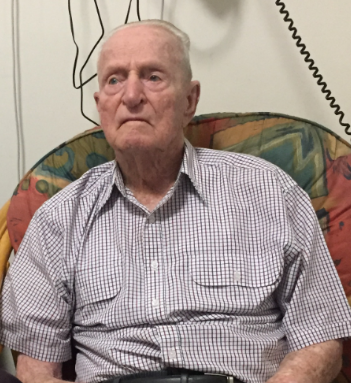Cornelis Geelhoed — An extraordinary 100 years
Cornelis (Kees) Geelhoed who recently celebrated his 100th birthday is a multinational veteran.
Mr Geelhoed served with the Dutch Air Force and was a Japanese Prisoner Of War (POW) for four years until the end of the Second World War. He later moved to Australia and served in the Royal Australian Air Force (RAAF) for 17 years.
Mr Geelhoed was born in Middelburg, Holland, on 7 June 1920. When his parents divorced, Mr Geelhoed then aged four, and his five older brothers, were put into a children’s home. He joined the Dutch Air Force at 18.
When the Second World War began, Mr Geelhoed worked as an engine fitter on fighter aircraft in Indonesia and became a POW after the Dutch surrender to the Japanese.


Mr Geelhoed in uniform (top-right) and now (bottom-right).
At great personal risk, he kept a detailed diary which he concealed from his captors. Mr Geelhold wrote on 22 April 1942, not long after becoming a POW:
‘We witnessed the execution of three countrymen. They were caught sneaking back into camp after spending the night with their families. The Japs made us all witness this barbaric act. Just on lunch time the three men were placed against a wire fence, hands tied behind their backs onto the wire fence. All commanders had to stand in close facing the victims, blindfolds were positioned. One of the big blond Dutchmen from Friesland refused the blindfold and spat in the Jap’s face. We were puzzled, surely they would no[t] shoot them with camp in the background. However, one must not think in a logical way when dealing with the Japanese conquerors, they used bay[o]nets 2 Japs for each man. This scene will always be in my memory as long as I live.’
Mr Geelhoed was shipped to Singapore, spending time in the notorious Changi Prison before being put to work on the Thai-Burma Railway.
Here Mr Geelhoed wrote in his diary under the dates 2 February till 1 March 1943:
‘I went down with dysentery. Our hospital was on the other side of the track separated from the rest of the camp. No buildings, no beds, no medicine only sick and dying patients. At night the tigers were prowling around our so called hospital. The only thing that stopped those beasts were the severe fires maintained all through the night, one could see their eyes and hear their growling. I witnessed young men not yet 20 years dying on that wretched jungle ground.’
After two years, Mr Geelhoed was shipped to Japan to work in forced labour camps until the end of the war. The camps were regularly subject to Allied bombing. On 12/13 July 1945, he wrote:
‘At midnight our camp received a direct hit. I was lucky the explosion knocked me and others straight through walls and we found ourselves outside the camp. Because we were on top of a water reservoir, the crater became a watery grave and it took us three days to account for all the victims. We lost 28 men — almost all were drowned, trapped like rats.’
On 15 August 1945, Mr Geelhoed wrote:
‘At about 1 o’clock we heard a voice over a distant radio. This was the voice of Hirohito, the Emperor of Japan. The war was over for the Japanese. That day we marched for the last time under Japanese command. …That night at roll call we were informed — no work tomorrow. We knew the war was over.’
Mr Geehoed was on a hospital ship anchored near the USS Missouri in Tokyo Bay when the surrender was signed on 2 September 1945:
‘Witnessed the signing of the peace which was carried out on “Flag Ship Missouri”. We watched history in the making from less than a mile away.’
After the war, Mr Geelhoed returned to Indonesia to recover personal photos and belongings buried there before his capture. He then worked on Mustangs for the Dutch Air Force at Bundaberg airfield and met Pearl, an Australian girl, who he married twelve weeks later.
Mr Geelhoed was transferred to Indonesia and he and Pearl lived there for a number of years. During the independence uprising in Indonesia, Mr Geelhoed left the Dutch military and he and his family moved to Australia in December 1949. As a result, he was not paid by the Dutch for his POW service. He finally received his persecution allowance many years later, after being interviewed by a doctor from Holland, who was left in tears hearing of Mr Geelhoed’s war experience.
Mr Geelhoed joined the RAAF. During 17 years’ service, he worked on many aircraft including Canberra bombers, Vampire jet fighters, and Aermacchi MB-326 jet trainers. He trained in the USA to learn aspects of plane maintenance, returning to work on F111s at Amberley. Leaving the RAAF aged 55, he maintained the Brisbane City Council’s pools until he retired.
Mr Geelhoed said the friendships he made were incredibly important.
‘I valued the mateship while serving and that is probably what helped me through some very tough times,’ he said.
He advises younger serving personnel to ‘take your opportunities when presented and enjoy life’.
Mr Geelhoed and his wife have three children, nine grandchildren and 16 great grandchildren. He credits his long life to ‘having such great children and family’.
Congratulations on your 100th Birthday Mr Geelhoed and thank you for your service.

Mr Geelhoed’s diary next to a mobile phone for size comparison.
